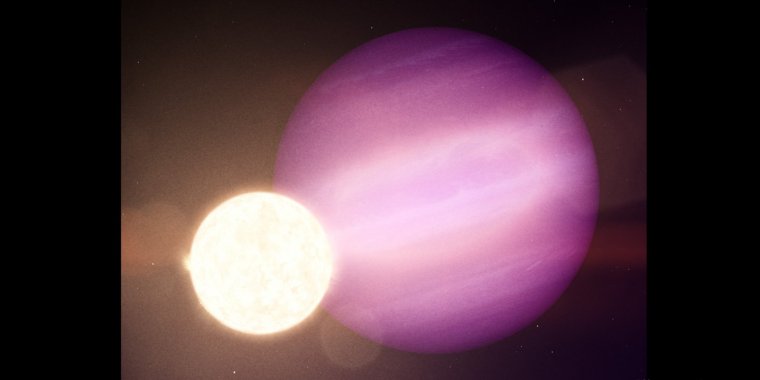| News / Space News |
NASA Missions Spy First Possible Planet Hugging a Stellar Cinder
An international team of astronomers using NASA's Transiting Exoplanet Survey Satellite (TESS) and retired Spitzer Space Telescope has reported what may be the first intact planet found closely orbiting a white dwarf, the dense leftover of a Sun-like star, only 40% larger than Earth.

WD 1856 b, a potential planet the size of Jupiter, orbits its dim white dwarf star every 36 hours and is about seven times larger. Credit: NASA's Goddard Space Flight Center
The Jupiter-size object, called WD 1856 b, is about seven times larger than the white dwarf, named WD 1856+534. It circles this stellar cinder every 34 hours, more than 60 times faster than Mercury orbits our Sun.
"WD 1856 b somehow got very close to its white dwarf and managed to stay in one piece," said Andrew Vanderburg, an assistant professor of astronomy at the University of Wisconsin-Madison. "The white dwarf creation process destroys nearby planets, and anything that later gets too close is usually torn apart by the star's immense gravity. We still have many questions about how WD 1856 b arrived at its current location without meeting one of those fates."
TESS monitors large swaths of the sky, called sectors, for nearly a month at a time. This long gaze allows the satellite to find exoplanets, or worlds beyond our solar system, by capturing changes in stellar brightness caused when a planet crosses in front of, or transits, its star.
The satellite spotted WD 1856 b about 80 light-years away in the northern constellation Draco. It orbits a cool, quiet white dwarf that is roughly 11,000 miles (18,000 kilometers) across, may be up to 10 billion years old, and is a distant member of a triple star system.
When a Sun-like star runs out of fuel, it swells up to hundreds to thousands of times its original size, forming a cooler red giant star. Eventually, it ejects its outer layers of gas, losing up to 80% of its mass. The remaining hot core becomes a white dwarf.
Any nearby objects are typically engulfed and incinerated during this process, which in this system would have included WD 1856 b in its current orbit. Vanderburg and his colleagues estimate the possible planet must have originated at least 50 times farther away from its present location.
The team suggests several scenarios that could have nudged WD 1856 b onto an elliptical path around the white dwarf. This trajectory would have become more circular over time as the star's gravity stretched the object, creating enormous tides that dissipated its orbital energy.
"The most likely case involves several other Jupiter-size bodies close to WD 1856 b's original orbit," said co-author Juliette Becker, a 51 Pegasi b Fellow in planetary science at Caltech in Pasadena. "The gravitational influence of objects that big could easily allow for the instability you'd need to knock a planet inward. But at this point, we still have more theories than data points."
Other possible scenarios involve the gradual gravitational tug of the two other stars in the system, red dwarfs G229-20 A and B, over billions of years and a flyby from a rogue star perturbing the system. Vanderburg's team thinks these and other explanations are less likely because they require finely tuned conditions to achieve the same effects as the potential giant companion planets.
Jupiter-size objects can occupy a huge range of masses, however, from planets only a few times more massive than Earth to low-mass stars thousands of times Earth's mass. Others are brown dwarfs, which straddle the line between planet and star.
Usually scientists turn to radial velocity observations to measure an object's mass, which can hint at its composition and nature. This method works by studying how an orbiting object tugs on its star and alters the color of its light. But in this case, the white dwarf is so old that its light has become both too faint and too featureless for scientists to detect noticeable changes. (NASA)
YOU MAY ALSO LIKE





